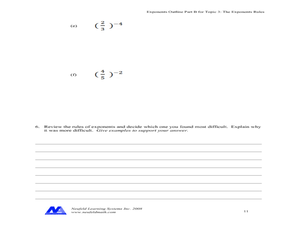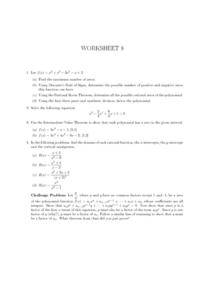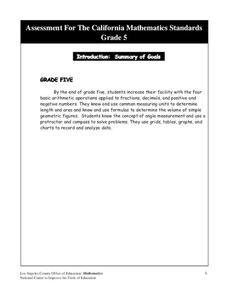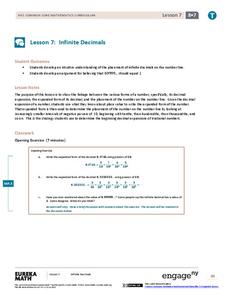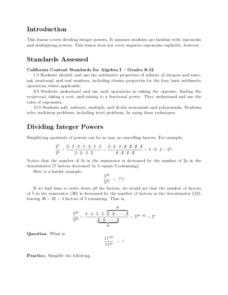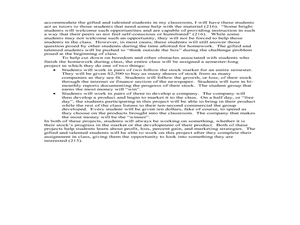Curated OER
Quiz: Exponents to Numbers and Compare Exponents
In this exponent worksheet, students multiply fractions and decimal numbers according to the given power and identify the value as a standard number. The integers contain both negative and positive exponents. This one-page worksheet...
EngageNY
Exponential Notation
Exponentially increase your pupils' understanding of exponents with an activity that asks them to explore the meaning of exponential notation. Scholars learn how to use exponential notation and understand its necessity. They use negative...
EngageNY
Magnitude
Build an understanding of the powers of 10. Pupils investigate the results of raising 10 to positive and negative powers. They relate this understanding to the magnitude these powers represent in this seventh lesson of 15.
Illustrative Mathematics
Households
Use an inverse linear function to interpolate a point. Presented with the number of households over a period of year, pupils find a linear function that will be a model. Class members determine the inverse of the linear function and use...
Curated OER
Dividing by Powers of Ten (A): 1/10^2
In this math worksheet, students are given 26 numbers which they are to divide by 10 to the -2 power. Once the students understand the procedure the answers are easy to find.
Curated OER
Multiplying By Negative Powers of Ten D
In this math worksheet, students practice using the operation of multiplication with whole numbers and decimals that extend to the thousandths place value.
Curated OER
Dividing by Negative Powers of Ten (C): 2-Digit Facts
In this math worksheet, students are given 10 numbers which they are to divide by 1, .1, .01, .001 and .0001. Once the procedure is understood, the answers are easy to find.
Curated OER
Exploring Exponents
Learners solve problems dealing with exponents. In this algebra lesson, students solve problems using interactive online problems. They create visuals and gain a better understanding of the concepts.
Curated OER
Fast Growing Plants
Negative exponents can be tricky, but this resource makes a mathematical conundrum an easier concept to grasp by relating the concept of exponents to the amount of time a plant has been owned. Fifth, sixth, and seventh graders will enjoy...
Curated OER
The Exponent Rules
For this Algebra I worksheet, 9th graders use the computer program Understanding Exponents to examine the laws of exponents. The worksheet is divided into an on computer and off computer component. The worksheet is eleven pages long...
Curated OER
Solving Quadratic Equations
In this quadratic equations activity, 9th graders solve 10 different problems that include various quadratic equations. First, they factor out the equation and set it to zero. Then, students solve each factor and check their work by...
Curated OER
Worksheet 8, Exponents
In this calculus worksheet, students analyze one equation by finding the maximum number of zeros. They use Descarte's Rule of Signs and the rational roots theorem. Students use synthetic division to factor the polynomial. Students solve...
Curated OER
Extreme Elevations
Seventh graders use highest and lowest points of land elevation around the world to find the differences. Sea level is zero, so students be operating with positive and negative numbers. After students find the information on the...
Los Angeles County Office of Education
Assessment for the California Mathematics Standards Grade 5
Test young mathematicians' knowledge with an assessment aligned to California's fifth grade state standards. The exam covers a multitude of concepts including fractions and decimals, positive and negative numbers, measurement; and how to...
EngageNY
Infinite Decimals
Can you support the argument that the decimal 0.99999 ... is equivalent to the number one? The seventh installment in this 25-part module gives convincing support for this conclusion. Pupils write infinite decimals using powers of 10....
Del Mar College
Quick Reference Card
A neat and organized formula handout makes the circle go round, doesn't it? Full of higher algebra topics, formulas and rules, graphs and definitions—there is a way to support everyone in Algebra II or Pre-Calculus.
Curated OER
Dividing Integer Powers
Work on the concept of using division with integer powers. The skills of using exponents and multiplying powers should be in place before attempting this lesson. The lesson provides examples for the teacher to use for direct instruction.
Curated OER
Comparison
In this comparison activity, students solve and compare given expressions. They determine the value of terms containing exponents. This one-page activity contains 10 problems. Answers are provided.
Curated OER
Scientific Notation
In this scientific notation worksheet, students review how to write a number in scientific notation and then how to write a number in standard notation. Then students complete 5 problems.
Curated OER
Convolution
In this convolution worksheet, students solve 8 different problems related to convolution. First, they determine the formulas for eight samples of f and g. Then, students write out the matrix found. In addition, they define the...
Curated OER
Squaring Function of Natural Numbers
Eighth graders complete problems where they use the definition of exponents to expand the squaring function of natural numbers. In this squaring natural numbers lesson plan, 8th graders also identify squares form 0 - 12 and complete a...
EngageNY
Estimating Quantities
Apply the concept of magnitude to estimate values and compare numbers. The ninth lesson of the 15-part series asks learners to write numbers to their next greatest power of 10 and then make comparisons. Scholars begin to understand the...
Curated OER
Imaginary Unit
In this imaginary unit activity, 9th graders solve 10 different problems that include solving with imaginary units. First, they define an imaginary unit as a number whose square is negative. Then, students solve each expression for x....
Curated OER
Solve for the Unknown
In this solving for the unknown worksheet, 11th graders solve 10 different equations that include determining the unknown variable in each one. First, they set up the equations so that the insides are equal to each other. Then, students...











